Copyright 2020 - 2021 irantour.tours all right reserved
Designed by Behsazanhost
Ganjali Khan complex
Ganjali Khan complex
Ganjali Khan is one of the most beautiful architectural and masterpieces Complex of the Safavid period in Kerman city. This magnificent building shines in Kerman's architecture like a gem, with special decorations, charity buildings, and public buildings. Each part of the set is a valuable Architecture work with the various ornament of Safavid art. This complex is one of the most beautiful Iranian Architecture cases. This beautiful square is consists of different monuments like Ganj Ali khan’s INN, mosque, bath, water cistern, and Bazar, that located around it. Thus each part of the set is a valuable Architecture work with the various ornament of the Safavid era.
 |
You can see various ornaments compounds including brick-work and tile-work, natural, herbaceous paints-design, and human, brutal paints-design in this historical complex. You can see some paintings, brick-made works, tile-works, and art-works on gypsum in the bathroom and water store that are different whit the Safavid ornament in Esfahan or the other cities.
 |
The Ganjali-Khan Complex is a large rectangular square with dimensions of 50 * 100 m. It is also famous as Khan Square. All sides of this magnificent square are covered with the different public, semi-public buildings, charity monuments, and government buildings like Mint. Important public or semi-public buildings such as a caravanserai are located on the east side, the public mosque on the northeast side, the public baths on the south, the water reservoir and school on the west, and the mint in the northern part.
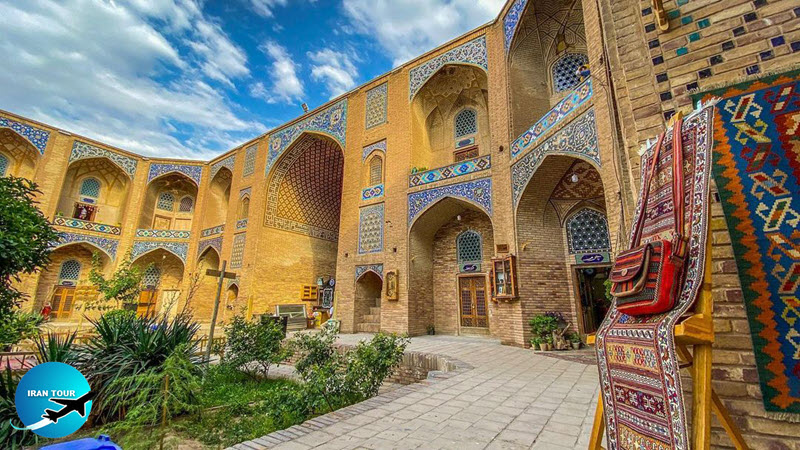 |
This historic square is surrounded on three sides by the passages of the Bazaar and a Chahar sooq. This whole complex is part of the endowments of Ganjali Khan, the most famous governor of Kerman (between the years 1005 to 1029 Ah). It is a simpler square than the Naghshe Jahan square but 1.17 times larger than it. The GanjaliKhan complex was also the third largest square in the city in its day. The date of formation of the square is 1005 A.H. (equivalent to 975 Hijri and 1597 A.D.), which roughly equates to the time of the construction of the Bazaar. After the square itself, the school is the oldest building in the complex (1007 A.H., equivalent to 977 Hijri and 1599 A.D.). Almost thirteen years later (1020 A.H., 990 Hijri, 1612 A.D.), the Ganjali-Khan bath was built. Then a year later, the caravanserai and the water tank were added. In general, it can be said that the Ganjali-Khan complex was built in the years 1005 to 1029Ad.
 |
Ganjalikhan complex is included different parts like:
Ganjalikhan square
This square like the other noble Iranian squares has a rectangular form, and is located in the center of the old city market with a length of 100 meters and a width of 54 meters.
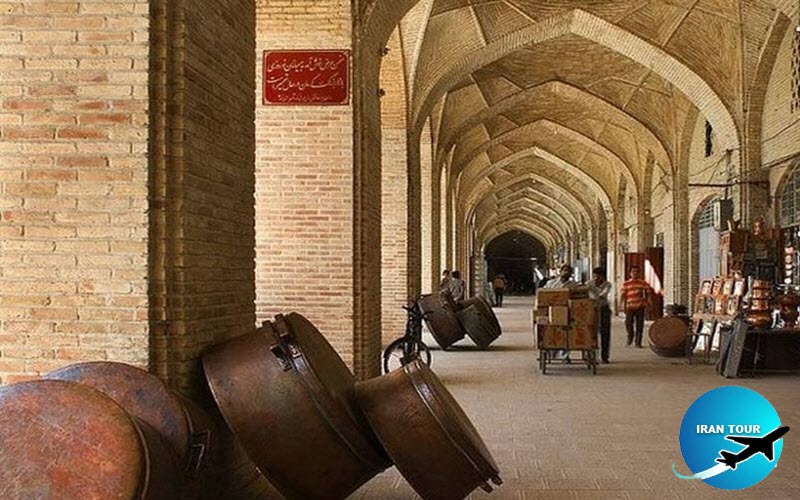 |
Ganjalikhan Bazaar
This Bazaar is between the cross marketplace and Ekhteyari bazaar, which remained as a memorial of interesting architectural style from the Safavid era and is in the southern of Ganjalikhan square, and is closed to the square from the left through 16 false arches.
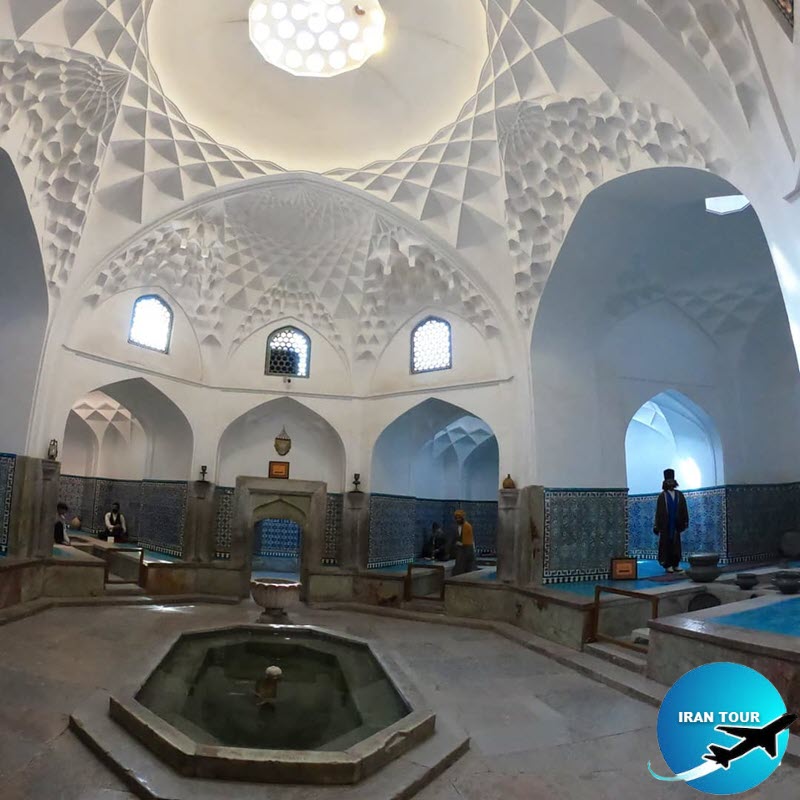 |
Ganjalikhan Bath
Ganjalikhan bath is on the right side of Ganjalikhan bazaar, this bath is a set of architectural art with various construction materials that created a suitable space with totally popular approaches. The bath is a novel and wonderful monument with beautiful tile working, painting, stucco working, false arches, and decorations that attract every viewer. This bath was in use until about 60 years ago, but it just serves as a tourist place and changed into an anthropology museum today.
Ganjalikhan Mint house
Ganjalikhan mint house is located in the northern corner of Ganjalikhan square, inside the northern coppersmithing market and in front of the bath. This complex decorates with beautiful stucco work. In the past, public silver and gold coins were minted there. Today it is in use as a coins museum, and there are many different coins from different periods.
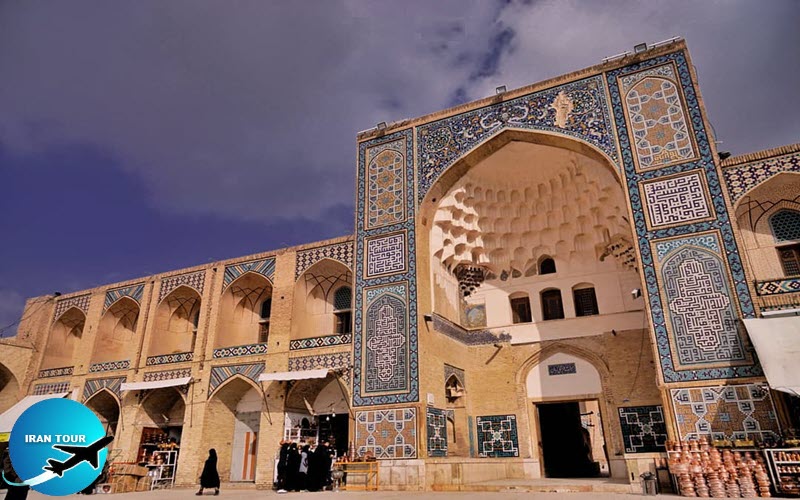 |
Ganjalikhan School
This School is located in the eastern corner of the square, it seems that it has been a school for some time and later changed into a caravansary. The outside and inside of this school have an interesting tile work that has been left as a memorial of the Safavid era. There are an epigraph and inscription on the school facade which shows the year construction of the building in 1007EC.
 |
Ganjalikhan mosque
This building is in the northeast corner of the square and close to the school. This small and private mosque is so beautiful, today it is in use as a small museum of Islamic decorative arts, such as tile working, stucco working, and calligraphy.
Ganjalikhan cross market place (charsoogh)
The cross-section of two series of shops is called Charsoogh. In the past Charsoogh was the most important center of the city, because the two series of shops from the north, south, east, and west of the bazaar cross each other on this point. The inside decoration of Charsoogh is with interesting stucco working and painting from the Safavid era that shows the citizen figures of that period. The Charsoogh dome was the highest dome in the city.
Abandbar (Alimardankhan's Reservoir water)
Alimardankhan water reservoir is located in the western corner of the square inside the western coppersmithing market and in front of the school, has an interesting architecture that attracts every viewer, today it is in use as a traditional coffee shop.
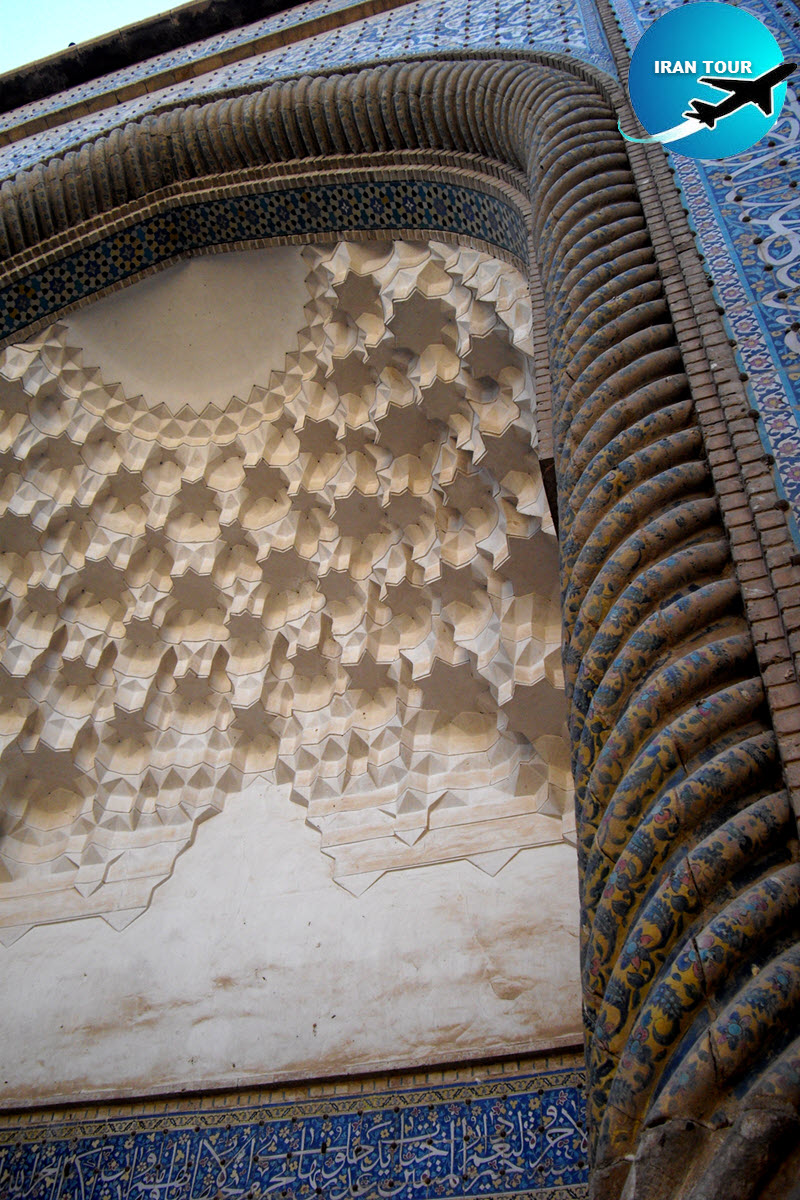 |
Ibrahim khan complex
Ibrahim khan Zahiraddole (1240,1218EC) was the Kerman governor in the Fatalishah era. He attempted to build worthy buildings in the city center near the Ganj ali khan complex, including the Gheisarie bazaar, bath, water reservoir, and school.
Goldsmith's bazaar
This bazaar is built in a Row of shops which is crossed to the hat felting (Kolah mali) bazaar that parallels the shoe bazaar. The school, bath, and water reservoir are located on both sides of the facade which has unique tile work. There are two big wooden doors at the beginning and the end of this bazaar that are closed on holidays.
Ibrahim khan School
In the center of Kerman, there is a beautiful and large school name Ibrahimkhan School. This school is located inside the Gheysarieh bazaar in the north of the old bazaar and Gangalikhan square. The building includes a royal pavilion, an altar, a balcony, and some stalls around. The inside decorations include Seven color tiles with the painting of flowers and bushes, vases, painting decorations, and stucco. There is also the highest and the most beautiful Kerman louver shown off at this school. The eastern balcony and o’clock tower of this school have beautiful tiles work and landscapes.
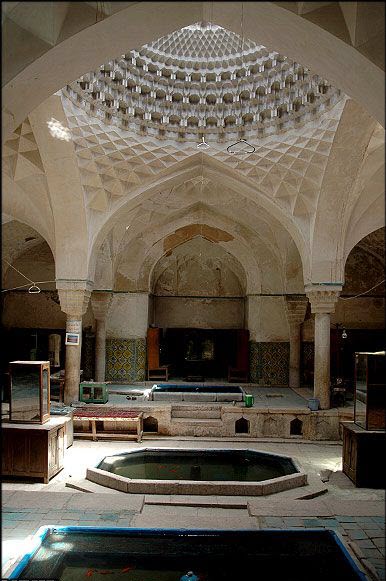 |
Ibrahim khan bath
This bath is near the school and in the center of the bazaar; some changes have been done to this bath, such as suitable piping and sanitary area, and today it is in use. This bath is divided into the dressing room and bathroom. It is in use from (1321 EC) until now.
Vakil complex
Mohammad Ismaeel khan Noori Esfandiary entitled to Vakilalmolk has been the governor of Kerman since 1275EC. During his governance, many buildings were constructed and reconstructed, such as the Vakil complex which includes: a bazaar, bath, caravansary, and mosque, in 1282EC with his and his son’s order (Mortaza Gholikhane Vakilalmolk sani).
Vakil public bath
The first part of the vakil complex is the bath and traditional coffee shop built in 1280EC that was constructed with magnitude Qajar engineering and architectural style and form. The floor and the walls are tile working, in recent years it is changed into a traditional coffee shop.
Vakil bazaar
At the end of the Ekhteiari bazaar, there is the Vakil complex and bazaar, this bazaar is so beautiful and corresponds to the Iranian bazaar to take a long, each trade part is located in a special place.
Vakil caravansary Vakil
This caravansary is located on the left side of Vakil bazaar and is the biggest caravansary in Kerman it is also regarded as a big caravansary in Iran. The caravansary’s entrance façade to the bazaar has beautiful stucco and tile works. It has two floors and also has long cylindrical louvers that make cooling the first floor rooms. At the present time, the caravan is being reconstructed and renovated. A five stars hotel and market center with 78000 m2 is going to be built by the cultural heritage handicrafts and tourism organization.
The history of Vakil Caravanserai of Kerman goes back to 170 years ago in the Qajar era. Construction of the said caravanserai was commenced at the order of Kerman governor Mohammad Esmaeil Khan Vakil Al-Molk about 1277-1284 AH and was completed in 1287 AH at the time of Morteza Gholi Khan Vakil Al-Molk. The building which consists of 120 rooms in two stairs, was located in the vicinity of the Ganjali Khan bazaar of Kerman and was used as a place for the accommodation of merchants and business offices since a long time ago. Vakil caravanserai has an area of about 11,000 m2, it is among the large caravanserais of Kerman, and in a sense, it is one of the largest caravanserais in the world.
 |
| Ganj Ali Khan Bath |
Ali Hajagha complex
This complex is located near to Ibrahimkhan complex and was built in the 13th Hejri century (Qajar era) includes a mosque, water reservoir, bazaar, and caravansary. Hajagha Ali was a famous merchant of Kerman. Additional to this complex, he had a luxurious house in Rafsangan which is in use today.
Hajagha Ali mosque (chehel setoon mosque)
This mosque is in Kerman Shariati Street and so far is active.
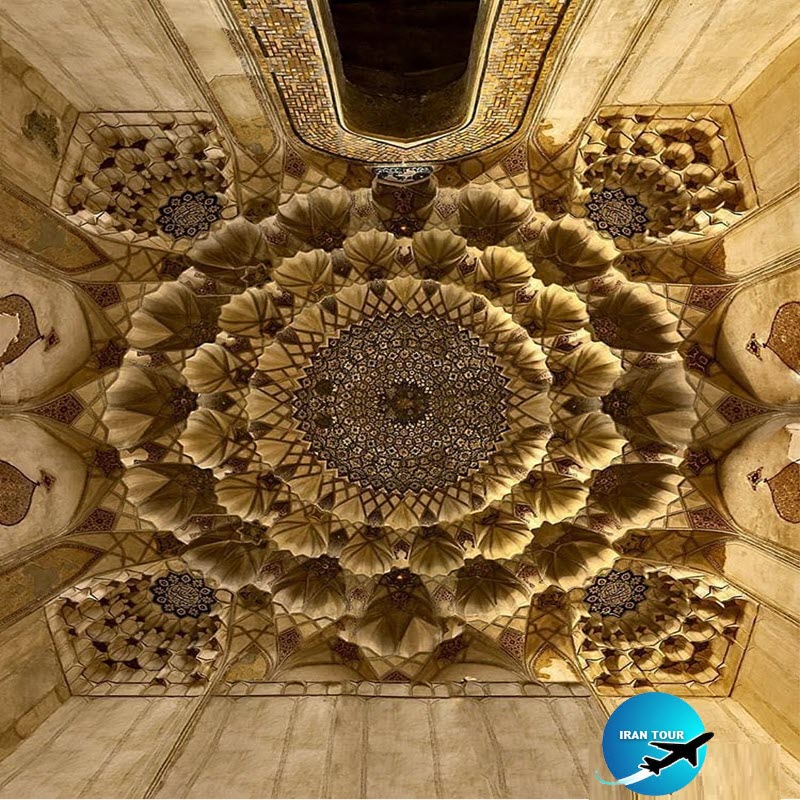 |
| The Entrance door of Ganj Ali Khan Mosque |
Kerman / Coppersmith Bazar
The building has 40 stony pillars which have been built skillfully. It is completed on1299EC.
Ali Hajagha bazaar
This bazaar begins from the end of the shoe bazaar and ends at Shariati Street in front of the Aziz bazaar. One of the tourism places along this bazaar is the Masoomeieh school of Hajagha Ali complex.
Ali Hajagha reservoir water
The water reservoir is located in front of Hajagha Ali mosque, its architectural construction is the same as other water reservoirs. One of the manifest specifications of that building is the façade that includes: stucco, painting decoration, and tile working that gives it a beautiful landscape.
- Details
- Category: Kerman HISTORICAL SITES